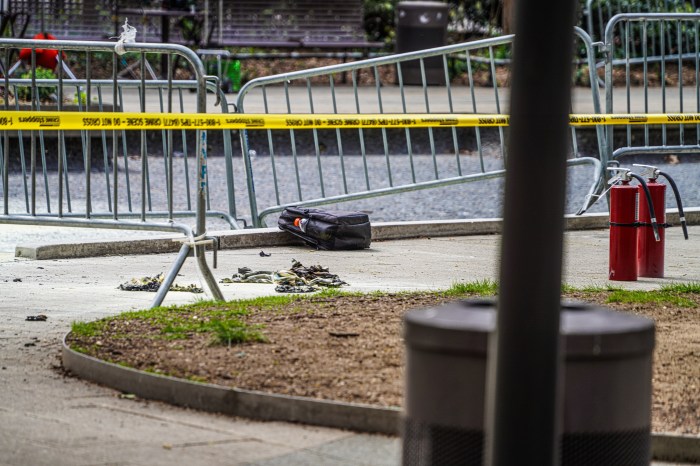By Joan Brown Wettingfeld
“There is something about a wedding-gown that is prettier than any other gown in the world.””
— Douglas Jerrold
The recent publicity about the Jacqueline Kennedy exhibit at the Metropolitan Museum of Art reminded me that what we wear is a part of our history and has been of interest to people down through the ages.
This is one such story.
She was petite and slender and her name was Sophie. A while ago I had my daughter model for me the dress that young Sophie wore for her wedding in 1880 and which was lovingly preserved as a family treasure. The beautiful dress was made over 100 years ago and I marvel at the condition of this precious family heirloom.
Sophie was my husband's paternal grandmother. Born in Germany in 1852, she later emigrated to New York City, and married Heinrich Wettingfeld in 1880. Their first home was on a small farm on West 137th Street in Manhattan. It was a time when the population in Manhattan was steadily moving uptown, though that area was still very rural.
In August 1896 Sophie and her husband moved to Bayside and purchased the farm that was to remain in the family until the end of World War II. The Wettingfeld farm consisted of 16 acres and extended from 48th Avenue, fronting on old Bell Avenue, now Bell Boulevard.
The farm was one of the many “truck farms” which proliferated on Long Island until the middle of the 20th century. The farmers grew vegetables which were sold to the produce markets in New York and the Bronx. Refrigerator rail cars and refrigerator trucks were not so available then, so truck farmers raised a wide variety of vegetables to satisfy the needs and tastes of the metropolitan markets.
Sophie was widowed in 1899 when her husband was killed in a wagon accident while returning from the market. From then until her death in 1904 she directed the operation of the farm with the assistance of her two young sons, Henry and William, and their cousin, Herman Cammann. The farm was the last in Bayside and there are still those today who will remember it as a local gathering place. I remember it well, for my husband-to-be and I would spend time there. I will never forget the morning just before we became engaged when I helped him to weed carrots and then went with him to look at a tractor that was for sale. A very unromantic beginning for a most momentous event!
In 1880 when young Sophie was married, wedding gowns as we know them today were not worn by most brides. Instead, the young women of that time made, or had made by a dressmaker, a dress that would be useful not only as bridal attire, but would serve for their honeymoon, and be practical for special occasions and “Sunday best’ in the future. The color chosen was usually neutral in tone.
Sophie's elegant dove-gray silk gown was entirely made by hand. It has wonderful draping, and finely pleated edging along the hemline. The bodice and sleeves are trimmed with tiny iridescent mother-of-pearl buttons, and the sleeves have fine lace edges. The collar is of satin and satin ribbon bows adorn the fitted bodice. The tiny waist is accented by a modified bustle.
After the ravages of the Franco-Prussian War in the 1870s, Paris for a time lost its influence on the world of fashion, and there began to be a change from extravagant styles and a return to greater simplicity. To us today, this hand-made wedding dress would be considered an exquisite and elegant work.
The sewing machine had been invented and aniline dyes had also been introduced by the 1880s, and this affected both the style and color of fashion. More colorful hues of fabric were available and more intricate details and trimmings could be added. Muted and neutral colors, however, were chosen and often preferred by many brides of the era. Skirts were still full at the back, but the bunched-up bustle had disappeared. Instead, the type of bustle revived in the 1880s as shown in advertisements of the day featured a “braided wire health bustle” warranted to “be less heating to the spine.” The Langtry bustle, named for the famous actress and courtesan, was a strange arrangement of metal bands working on a pivot. This allowed it to be raised when sitting down, and would spring back automatically when the lady wearing it arose. An extraordinary invention!
In viewing fashion of the 1880s some reference has to be made to a movement then coming to the fore. The Rational Dress Movement essentially followed the dictates of then current fashion but railed against corsets and formal hair styles. The followers of the movement were concerned with counteracting what they believed to be the unhealthy aspects of fashion. That is entirely understandable and they protested not only the deforming tight corset, but padding and boning as well.
Though not widely espoused, the movement eventually achieved its aims . The change, however, can be attributed to the fact that women began to lead more active lives, and narrow rigid corsets became impractical and thus unfashionable. The story of the movement is only an interesting sidelight, for I am sure it did not touch Sophie’s life nor that of many of her contemporaries here in the then-rural village of Bayside.
There is a tale attached to every family treasure, for artifacts and heirlooms have as much to tell us as do diaries, journals, and written documents. To search them out is a kind of above-ground archaeology. Somewhere each of us has something from our yesterdays that speaks of history and our own important story.
Joan Brown Wettingfeld is an historian, free-lance writer and a member of the Borough President’s History Advisory Committee.































